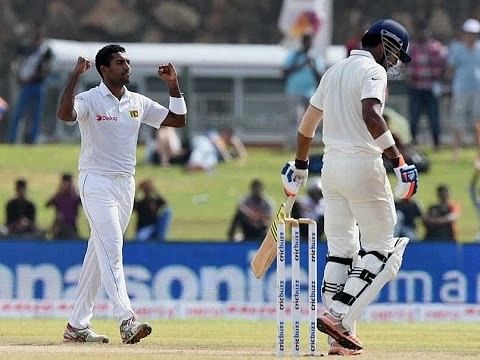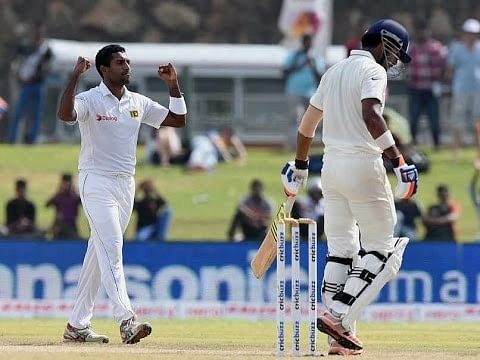
Indian top order's technical insufficiencies exposed by the Sri Lankan pacers

The Sri Lankan pacers have been an absolute nightmare for the Indian top order batsmen in the ongoing Test series, especially the openers. Dhammika Prasad’s extravagant movement which either comes back in or leave away from the batsmen and Nuwan Pradeep’s deceptive pace and incoming deliveries have made life tough for the Indian top order.
No doubt, Prasad has been one of the most outstanding performers throughout this Test series, but with due respect to the other Sri Lankan pacers as well, the technical insufficiencies of the Indian top-order batsmen have played a big role in their dismissals.
In the first Test at Galle, during India’s first innings, Dhammika dished out a delivery which moved back to trap KL Rahul who had moved forward plumb in front. Umpire Bruce Oxenford raised his finger after a vociferous appeal from the hosts. Murali Vijay succumbed in a similar manner in the second Test after Vijay, like Rahul, came forward too quickly and tried to counter the movement on the front foot.
In the third Test, Nuwan Pradeep banged in a fuller delivery targeting the middle and leg stump and Rahane, rather than going back, tried to counter the movement with his front foot but was trapped leg before as the ball hit his back leg.
The above-mentioned dismissals show that the Indian batsmen are not well-equipped against the incoming deliveries. The Indian opening and top order batsmen tried to play the moving ball, especially those which nipped back in, on the front foot, whereas they should have negotiated those on the back foot allowing themselves more time to play the ball late.
Dhammika Prasad has been effulgent and smart enough as well in exploiting the weakness of the Indian batters. More assurance on the back foot would have helped the Indian top order in handling the movement quite well.
The reasons for the unwanted tendency of playing the ball regularly on the front foot
Whenever a batsman goes on the back foot, a plethora of strokes crops up and aids him to exhibit the shots in the most authoritative manner. By playing the moving ball on the front foot always invites fatal outcomes and the Indian batsmen are experiencing this quite well.
Such a technical insufficiency is not only seen among the Indian or subcontinental batsmen alone but the majority of the modern day batsmen who tend to have such a glitch in their technique. In the recently concluded Ashes series, the Australian top order was at bay when the English pacers moved the ball at will. Even the World’s No 1 Test batsman, Steve Smith, was seen like a novice against the moving ball.
In the good old days, openers like Sunil Gavaskar or Graham Gooch were seen to open their account by getting on the back foot against the incoming deliveries with confidence and glancing the ball towards the fine leg region. At present, there is more tendency to play any sort of deliveries on the front foot.
One of the most important reasons for the above might be the overdose of Twenty20 cricket which puts the emphasis on trying to score off every ball. Secondly, the lack of sporting tracks in domestic cricket. By playing on placid tracks, a batsman can never develop the habit of using his back foot appropriately.
And finally, there is no use of the ‘dukes’ ball in domestic cricket. In the subcontinent, Kookaburra and SG balls are used more which at one stage becomes more useful for the spinners. The ‘dukes’ ball aids more swing and facing such deliveries regularly will strengthen the batsman’s technique against swing bowling as well.